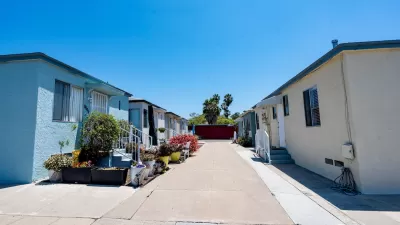If it approves HB 1797, Washington will pace the rest of the nation (even California and Oregon) on reforming zoning to allow more accessory dwelling units.

"This morning, Washington House Representatives Mia Gregerson (D-SeaTac) and Andrew Barkis (R-Olympia) introduced the most progressive accessory dwelling unit (ADU) bill legislators from any state have ever had the opportunity to vote on," reports Margaret Morales.
The legislation applies to all cities in Washington with 2,500 residents or more. Here, Morales provides a list of the regulatory changes included in the far-reaching bill, as described exactly in the article:
- Permit two ADUs per lot wherever there is a single-family home, duplex, triplex, or townhome
- Eliminate off-street parking, owner-occupancy, and minimum lot size requirements
- Cap impact fees at 50 percent of those for single-family homes
- Set utility connection fees and capacity charges in proportion to the ADU’s burden on the utility system
- Increase design flexibility via more generous setback, height, and size limits
For comparison's sake, Morales says this law, if passed, would be more comprehensive and impactful than laws approved in the state of Oregon and California in recent years.
ADU policy in Washington is already fickle. Locals pushed back on ADU reform approved by the state in 1993, but Washington cities that have recently allowed more permissive ADU regulations have seen a resulting spike in permits, according to Morales.
FULL STORY: CAN WASHINGTON PASS THE COUNTRY’S MOST AMBITIOUS STATEWIDE ADU REFORM?

Maui's Vacation Rental Debate Turns Ugly
Verbal attacks, misinformation campaigns and fistfights plague a high-stakes debate to convert thousands of vacation rentals into long-term housing.

Planetizen Federal Action Tracker
A weekly monitor of how Trump’s orders and actions are impacting planners and planning in America.

In Urban Planning, AI Prompting Could be the New Design Thinking
Creativity has long been key to great urban design. What if we see AI as our new creative partner?

King County Supportive Housing Program Offers Hope for Unhoused Residents
The county is taking a ‘Housing First’ approach that prioritizes getting people into housing, then offering wraparound supportive services.

Researchers Use AI to Get Clearer Picture of US Housing
Analysts are using artificial intelligence to supercharge their research by allowing them to comb through data faster. Though these AI tools can be error prone, they save time and housing researchers are optimistic about the future.

Making Shared Micromobility More Inclusive
Cities and shared mobility system operators can do more to include people with disabilities in planning and operations, per a new report.
Urban Design for Planners 1: Software Tools
This six-course series explores essential urban design concepts using open source software and equips planners with the tools they need to participate fully in the urban design process.
Planning for Universal Design
Learn the tools for implementing Universal Design in planning regulations.
planning NEXT
Appalachian Highlands Housing Partners
Mpact (founded as Rail~Volution)
City of Camden Redevelopment Agency
City of Astoria
City of Portland
City of Laramie





























